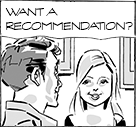Page 45 Review by Stephen
Lord, I love the rain! In the countryside during summer, accompanied by the smell of freshly cut grass; on leaves, on water, on canvas, on glass; but even in the city, at night.
When it hits here halfway through - as our beleaguered everyman emerges from the infernal subway which is dark and dangerous yet potentially thrilling in a primal way - it comes to me a blessed relief. There seems to be very real light at the end of that tunnel as the rain pours from the heavens onto the concrete steps below.
But an enormous clock tower is cast in stark contrast, silhouetted against the sky - boy, have we boxed in our lives not just with buildings but with time itself! - and the rain is far from fun for the man sat in it, cold, barefooted and holding out a cup rapidly filling with nothing but water.
Our hero is homeless too: he lost his job, he lost his lover then, evicted, he lost his apartment. His heart is exposed, vulnerable, for you to see.
From the creator of the equally eloquent and political BLOOD SONG comes a hardcover reprint of his first wordless narrative composed of three chapters created at intervals during a seven-year span and you can see Drooker as an artist develop in front of you on the page. (In some early panels Robert Crumb leaps out at you.)
It's a decidedly surreal yet all too real nightmare of life in the far from civilised city. Anyone who's read BLOOD SONG knows that Drooker's no fan. He grew up in New York and was a first-hand witness to the tyranny of landlords and hostile police action evicting squatters from a tenement building, and an entire population from a supposedly public park in riot gear, on horseback, just because. He sees the city as a cruel and fickle oppressor which man has created and ended up shackling his natural self as a slave to its grinding regime. It's a despair-inducing chronicle of melancholia, isolation, alienation, and helplessness; a freakshow of the rejected, the dejected and the chaos of hoards before the storm. And when the storm hits, it pours into the city and sweeps all away.
The expressionistic art - an essay in black and white long before Miller's SIN CITY - is extraordinarily versatile, speeding up, then slowing down, moving in then moving out, and when the blue tone joins it just after the deluge itself it is quite awesome to behold. As to the rain itself, the subtractive medium of scratchboard is perfect for sheets and sprays of water which erode what we can see beyond them. I am a massive fan of rain drawn by the likes of Sacco and Eisner and indeed Miller in the original SIN CITY, but here it positively hurtles across the page, buffeting our man beyond his ability to resist before sweeping him up into the stormy sky, over the rooftops, past the Statue Of Liberty and - immediately and tellingly afterwards - away from the barred window of a crowded prison cell as its inmates look impotently out.
It ends in the prophecy of another watery Armageddon which harks back to the first - the only way to silence the babble and brutality.
For a silent graphic novel, this is one hell of a noisy book.
"Pictures are a means of communicating with people when words feel inadequate. It's a way of bridging the language barrier," says Drooker in the interview afterwards.
"Pictures are a more direct language than words. Words are always one step removed, because we're encoding what we're trying to express into verbal symbols - which need to be deciphered. Pictures are the earliest form of writing, and drawing them is something we do as young children - long before learning to read and write."
It's a fascinating interview raising points I hadn't thought of before like this:
"Frankly I feel that our Judeo-Christian culture places undue emphasis on the word: "In the beginning was the word." Other forms of expression - particularly images are sacrilege. The second commandment given to Moses was: "Thou shalt not make unto thee any graven image, nor any likeness of anything that is in heaven above, or that is in the earth beneath, or that is in the water under the earth." Jehovah is very explicit: images are taboo.
The one thing that the powers that be have always sought to control is communication.

